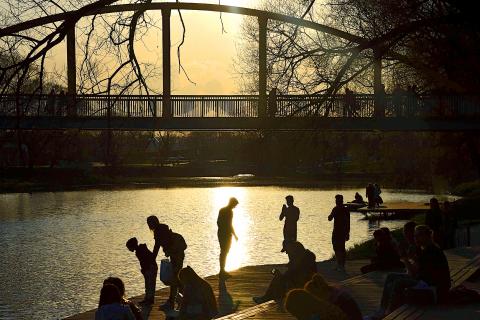For decades, the banks of the river flowing through the Russian city of Belgorod were in a sorry state of disrepair.
“It was hard to get down to the water and it was really filthy in places,” architect Jezi Stankevic said.
Now reeds line the waterfront and teenagers lounge on wooden boardwalks that extend right across the river, overlooked by a wooden amphitheater.

Photo: AFP
The idea of creating pleasant public spaces might not seem groundbreaking, but it is only just taking root in Soviet-planned cities like Belgorod, about 600km south of Moscow.
Such cities were built with the aim of fulfilling production targets rather than responding to the needs of residents, said Daria Paramonova, of the Strelka architecture firm leading the project.
The Moscow-based firm has been awarded a contract to oversee the regeneration of 40 cities under a government program launched in 2017.
The ongoing drive is “the largest urban regeneration project in post-Soviet Russia,” Strelka said.
It comes as the country struggles to halt a tide of young people moving from the provinces to the capital in search of opportunities.
The notion of “quality of life” was initially alien to residents, whose needs and wishes had formerly not been a priority for city planners, Paramonova said.
“Now we say that what’s important is keeping things human,” she said, stressing the role of public consultations before taking decisions.
Residents of Belgorod, a provincial city of about 400,000 inhabitants that was rebuilt after World War II, attended public meetings and were able to vote online for their favorite design project.
The riverside area where people can now stroll, play sports and walk their dogs, is just the start.
The goal is to extend walkways and cycle paths over 20km along the river. Strelka took charge for the initial stages and is to advise local officials and architects on the rest.
Other cities lined up for a makeover of their public spaces include Russia’s third-biggest city Ekaterinburg; Vladivostok; Grozny, where a new park was created; and Novosibirsk.
Like many Russian cities, Belgorod has seen an exodus of young people since the breakup of the Soviet Union in 1991 and closure of many local factories. As a result, budgetary revenues have fallen and regeneration projects have slipped right down the agenda.
While some have questioned how Belgorod will maintain costly new facilities, those using them — from students at a nearby university to young mothers with strollers — said that they have been a hit since opening in November 2017.
“It has really got prettier,” said Yelena, a 38-year-old quality control specialist walking in the spring sunshine. “You’re in the center of the city, but you don’t hear any traffic noise. I’d even call it calming.”
Since 2010, the Kremlin has spent billions of dollars on improving public spaces, particularly through a federal program that has handed out 42.2 billion rubles (US$648.1 million at the current exchange rate) for renovation work.
Russian President Vladimir Putin last year asked the government to double its contributions to create a “comfortable urban environment.”
Paramonova highlighted the positive impact that Moscow’s successful — and costlier — “My Street” renovation scheme has had on getting the provincial rejuvenation project off the ground.
Initiated in 2015, it radically changed the face of Moscow ahead of last year’s FIFA World Cup.
The project’s costs controversially soared to 126 billion rubles and it was tarnished by accusations of corruption by municipal authorities.
However, Muscovites now rarely recall the three summers of noisy, dusty renovation work.
It is tricky to take the same ideas to the provinces, “where there is less money and more problems,” Paramonova said.
However, she said she hopes that Strelka’s work will encourage local architects to develop their own projects.
Making provincial cities more attractive places to live in is crucial to ensuring their survival, local authorities have said.

To many, Tatu City on the outskirts of Nairobi looks like a success. The first city entirely built by a private company to be operational in east Africa, with about 25,000 people living and working there, it accounts for about two-thirds of all foreign investment in Kenya. Its low-tax status has attracted more than 100 businesses including Heineken, coffee brand Dormans, and the biggest call-center and cold-chain transport firms in the region. However, to some local politicians, Tatu City has looked more like a target for extortion. A parade of governors have demanded land worth millions of dollars in exchange

An Indonesian animated movie is smashing regional box office records and could be set for wider success as it prepares to open beyond the Southeast Asian archipelago’s silver screens. Jumbo — a film based on the adventures of main character, Don, a large orphaned Indonesian boy facing bullying at school — last month became the highest-grossing Southeast Asian animated film, raking in more than US$8 million. Released at the end of March to coincide with the Eid holidays after the Islamic fasting month of Ramadan, the movie has hit 8 million ticket sales, the third-highest in Indonesian cinema history, Film

Taiwan Semiconductor Manufacturing Co’s (TSMC, 台積電) revenue jumped 48 percent last month, underscoring how electronics firms scrambled to acquire essential components before global tariffs took effect. The main chipmaker for Apple Inc and Nvidia Corp reported monthly sales of NT$349.6 billion (US$11.6 billion). That compares with the average analysts’ estimate for a 38 percent rise in second-quarter revenue. US President Donald Trump’s trade war is prompting economists to retool GDP forecasts worldwide, casting doubt over the outlook for everything from iPhone demand to computing and datacenter construction. However, TSMC — a barometer for global tech spending given its central role in the

Alchip Technologies Ltd (世芯), an application-specific integrated circuit (ASIC) designer specializing in server chips, expects revenue to decline this year due to sagging demand for 5-nanometer artificial intelligence (AI) chips from a North America-based major customer, a company executive said yesterday. That would be the first contraction in revenue for Alchip as it has been enjoying strong revenue growth over the past few years, benefiting from cloud-service providers’ moves to reduce dependence on Nvidia Corp’s expensive AI chips by building their own AI accelerator by outsourcing chip design. The 5-nanometer chip was supposed to be a new growth engine as the lifecycle